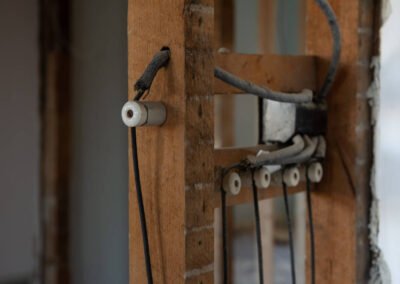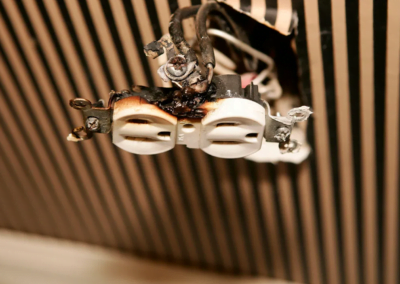Replace Old, Unsafe Wiring, Toronto
Older homes typically use the “knob and tube” wiring method or aluminum wiring, which are outdated and can be unsafe. We can assess your home for safety and replace old wiring with safer systems.
Request InformationSchedule Service
Replace Old, Unsafe Wiring, Toronto
The type of wiring that your home currently has can depend on its age and the last time that renovations were done by the previous owner. For modern homes, it’s likely that they have the most up-to-date copper wiring, while older homes typically have more outdated systems like aluminum wiring (popularized from the 1960s to mid-1970s when copper was still relatively expensive) and knob and tube wiring (an earlier open-wire system used during the first wave of residential electrical installations between the 1900s to 1950s).
These older systems are now deemed safety hazard by modern regulations. Since electrical wiring tends to be hidden behind walls and are by design meant to be concealed, it’s easy to forget about its importance in the healthy functioning of your home. However, now more than ever, replace your old, unsafe wiring to live safely and hassle-free without the annoyances (and dangers) of tripping breakers, dying outlets, and flickering lights.
A house that has aged for some decades is likely ready for an electrical wiring upgrade, as it’s bound to cause problems around the home. With how far technology has come within just the last 10 years, homes wired with older and weaker systems are unlikely to be compatible with the modern electrical needs of today and the future going forward. Having your electrical distribution equipment up-to-date is especially crucial for safety reasons, as statistics show that faulty wiring and outlets are one of the top causes of residential structural loss, causing an average of hundreds of house fires per year.
Especially for knob and tube wiring, which is connected by distinct white ceramic knobs/tubes, wrapped in a rubberized cloth, and suspended into the air (lacking grounding), the risk of electrocution and fires is increased significantly due to its exposed nature and tendency to overheat. Knob and tube wiring is usually found in basements and attics, but can even be hidden behind walls by previous homeowners worried about insurance issues, since companies tend to be hesitant about insuring homes with outdated and unsafe wiring.
Aluminum wiring became popular for its malleability and lightweight properties, making it easy to work with and use over long distances. Back before copper wiring was more accessible, aluminum was seen as much more cost-effective, but over time it’s become more apparent that its softness can present a fire hazard due to its tendency to come loose from terminals, fray, and wear down. Although still viable as of 2021, the ESA recommends that it be maintained and inspected by a professional every 3-5 years. Making the switch to copper wiring can reduce this need and save you money on maintenance costs.
The longer you leave electrical distribution systems to age, the more expensive replacing them tends to become. It’s first imperative to have your home assessed, having a licensed professional check behind the walls, to determine whether re-wiring is needed and what the best course of action to take is.
Contact MADE ELECTRIC for more information on replacing old, unsafe wiring! We operate within the GTA to assess the safety of your home and ensure that it’s operating with the safest possible wiring system.
Frequently Asked Questions (FAQs)
Why is copper wiring better than K&T or aluminum wiring?
How much will re-wiring my home cost?
This can depend on several factors, though the average cost of an entire re-wire for the home using copper is typically $10,000 CAD upwards. The cost varies greatly based on the square footage or the size of your home (determining the lengths of wiring that will be needed), the age of your home since the last renovation (showing how much work will need to be done and how long a complete overhaul will take), and the licensed electrical contractor that you choose.
The longer you wait to upgrade your wiring, however, the more expensive you can expect it to be. A home that goes several decades without modernizing can accumulate to over $30,000 of needed upgrades, most of which will be required by law or for insurance purposes anyway. If you plan on long-term ownership, it’s much better to get it done sooner than later.
Factors can include the cost of opening up the walls, the cost of materials and labour, whether enhancement wiring is preferred (to ensure that the wires are secure), and permit acquisition costs. For any questions, contact MADE ELECTRIC today!
Can you fix work done by an unlicensed electrician?
MADE ELECTRIC offers re-wiring services and any work done by unlicensed individuals should definitely be inspected as soon as possible. Since residential wiring is such a large project and a very complicated process, hiring a professional to fix up any work done by previous homeowners can save you a lot of expense in the long run.




